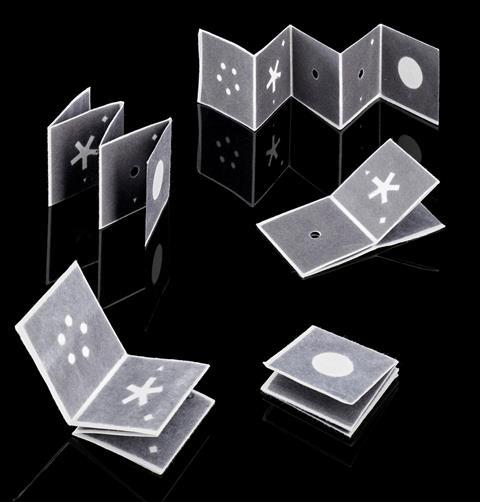Researchers at Cranfield University have developed an innovative new method for identifying biomarkers in wastewater using origami-paper sensors, enabling the tracking of infectious diseases using the camera in a mobile phone. The new test device is low-cost and fast and could dramatically change how public health measures are directed in any future pandemics.

Testing wastewater is one of the primary ways to assess the prevalence of infectious diseases in populations. Researchers take samples from various water treatment plants around the country and use the results to understand which areas currently have the highest infection rates. The method was used in the COVID-19 pandemic to track community infection rates and direct public health measures.
READ MORE: Researchers craft ‘origami DNA’ to control virus assembly
READ MORE: Bacterial biotechnology to remove phosphorus from wastewater given funding boost
Zhugen Yang, Professor of Biosensing and Environmental Health at Cranfield University, led the development of the sentinel sensors. It builds on research he conducted in 2020 to develop a test to detect SARS-CoV-2 (commonly known as COVID-19), Influenza A and Influenza B in wastewater using a paper-based platform and UV torch or mobile phone camera.
PCR test
Until now, the most accurate ways of testing wastewater samples have been methods like the polymerase chain reaction (PCR) test which must be conducted in centralised laboratories by well-trained personnel. That means samples are collected, stored and transported in a cold chain to the lab location before being processed, which can take multiple days and is comparatively expensive.
The new test method is rapid, user-friendly and portable. Wastewater samples are placed onto a wax-printed paper sheet which is folded in an ‘origami’ style. The paper contains chemicals that react to certain disease markers, triggering a fluorescent colour to emerge. Using a mobile phone camera, the results can be read and data collected rapidly
Professor Yang developed the new method as part of the national COVID-19 wastewater surveillance programme. In 2021, at the height of the pandemic, he performed field tests using the test at four quarantine hotels around Heathrow Airport. The whole sample-to-answer process took under 90mins compared to around four hours for a PCR test, with the tests conducted in the basement of one of the hotels using minimal equipment. Results showed that this new device gives results at least as accurate as the PCR test but at a much lower cost and can provide an early warning of disease in the community. The device is particularly useful for areas with limited resource because of its ease of use, low cost and fast results.
Community sewage analysis
Professor Yang commented: “During COVID-19 we proved that fast community sewage analysis is a really effective way to track infectious diseases and help manage public health. The simple test we have developed costs just £1 and uses the commonly available camera function in a mobile phone, making it readily accessible. This could be a real game-changer when it comes to predicting disease rates and improving public health in the face of future pandemics.”
The device has been featured at the London Science Museum recognising its contribution to the National Wastewater Surveillance Programme during the COVID-19 pandemic.
Further development of the test is being sponsored by the Leverhulme Trust Research Leadership Scheme and a grant from the Biotechnology and Biological Sciences Research Council. In future, it could potentially be used to track new variants and help to establish whether the variant is still spreading in the community, as well as monitoring antimicrobial resistance from one health perspective.
Paper microfluidic sentinel sensor enables rapid and on-site wastewater surveillance in community settings is published in the journal Cell Reports Physical Science, and also involved scientists from the University of Glasgow and Zhejiang University in China.
Topics
- Asia & Oceania
- biomarkers
- Clean Water
- Clinical & Diagnostics
- COVID-19
- Cranfield University
- Economic Equality
- Infectious Disease
- influenza A
- influenza B
- Innovation News
- National Wastewater Surveillance Programme
- One Health
- origami
- Rapid Diagnostics
- SARS-CoV-2
- UK & Rest of Europe
- University of Glasgow
- Wastewater & Sanitation
- Zhejiang University
- Zhugen Yang







No comments yet